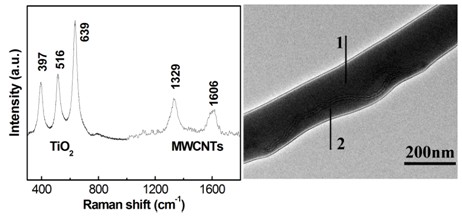Method for improving performance of nanofiber membrane of dye-sensitized battery by synergistic action of carbon nanotubes and titanium tetrachloride
A technology of dye-sensitized cells and nanofiber membranes, applied in circuits, photovoltaic power generation, electrical components, etc., can solve the problems of reduced electronic life and diffusion distance, increased recombination probability, and restricted battery efficiency, so as to improve photocurrent density and short-circuit current Isc, increase the intensity, and improve the effect of photoresponse
- Summary
- Abstract
- Description
- Claims
- Application Information
AI Technical Summary
Benefits of technology
Problems solved by technology
Method used
Image
Examples
Embodiment 1
[0025] 0.68g PVAc was added to 4ml DMF organic solvent to form a solution with a mass percentage of 15wt.%, and 1ml Triton X-100, 0.5ml HAc, and 1.36g TiP were added to the solution; magnetic stirring was carried out for 8 hours to obtain clarification, Viscous TiO 2 The precursor is spin-coated liquid, and it is spin-coated on the FTO conductive glass ultrasonically cleaned with acetone and absolute ethanol using a spin-coating machine to form a spin-coating layer. The spin-coating machine speed is 2000r·min -1 , Spin coating time is 30s.
[0026] 0.52g PVAc was added to 4ml DMF to form a solution with a mass percentage of 11.5wt.%, and 0.6ml Triton X-100, 0.4ml HAc, and 1.04g TiP were added to the solution. Subsequently, MWCNTs with a molar percentage of 0.1% TiP were also added to the DMF solution. Magnetic stirring for 8h to obtain TiO 2 Precursor spinning solution 1, and ultrasonic for 2h to ensure the uniform dispersion of MWCNTs in the solution; put the precursor spinning ...
Embodiment 2
[0029] 0.68g PVAc was added to 4ml DMF organic solvent to form a solution with a mass percentage of 15wt.%, and 1ml Triton X-100, 0.5ml HAc, and 1.36g TiP were added to the solution; magnetic stirring was carried out for 8 hours to obtain clarification, Viscous TiO 2 The precursor is spin-coated liquid, and it is spin-coated on the FTO conductive glass ultrasonically cleaned with acetone and absolute ethanol using a spin-coating machine to form a spin-coating layer. The spin-coating machine speed is 2000r·min -1 , Spin coating time is 30s.
[0030] 0.52g PVAc was added to 4ml DMF to form a solution with a mass percentage of 11.5wt.%, and 0.6ml Triton X-100, 0.4ml HAc, and 1.04g TiP were added to the solution. Subsequently, MWCNTs with a molar percentage of 0.5% TiP were also added to the DMF solution. Magnetic stirring for 8h to obtain TiO 2 Precursor spinning solution 1, and ultrasonic for 2h to ensure the uniform dispersion of MWCNTs in the solution; put the precursor spinning ...
Embodiment 3
[0033] 0.68g PVAc was added to 4ml DMF organic solvent to form a solution with a mass percentage of 15wt.%, and 1ml Triton X-100, 0.5ml HAc, and 1.36g TiP were added to the solution; magnetic stirring was carried out for 8 hours to obtain clarification, Viscous TiO 2 The precursor is spin-coated liquid, and it is spin-coated on the FTO conductive glass ultrasonically cleaned with acetone and absolute ethanol using a spin-coating machine to form a spin-coating layer. The spin-coating machine speed is 2000r·min -1 , Spin coating time is 30s.
[0034] 0.52g PVAc was added to 4ml DMF to form a solution with a mass percentage of 11.5wt.%, and 0.6ml Triton X-100, 0.4ml HAc, and 1.04g TiP were added to the solution. Subsequently, MWCNTs with a molar percentage of 1% TiP were also added to the DMF solution. Magnetic stirring for 8h to obtain TiO 2 Precursor spinning solution 1, and ultrasonic for 2h to ensure the uniform dispersion of MWCNTs in the solution; put the precursor spinning so...
PUM
 Login to View More
Login to View More Abstract
Description
Claims
Application Information
 Login to View More
Login to View More - R&D
- Intellectual Property
- Life Sciences
- Materials
- Tech Scout
- Unparalleled Data Quality
- Higher Quality Content
- 60% Fewer Hallucinations
Browse by: Latest US Patents, China's latest patents, Technical Efficacy Thesaurus, Application Domain, Technology Topic, Popular Technical Reports.
© 2025 PatSnap. All rights reserved.Legal|Privacy policy|Modern Slavery Act Transparency Statement|Sitemap|About US| Contact US: help@patsnap.com



